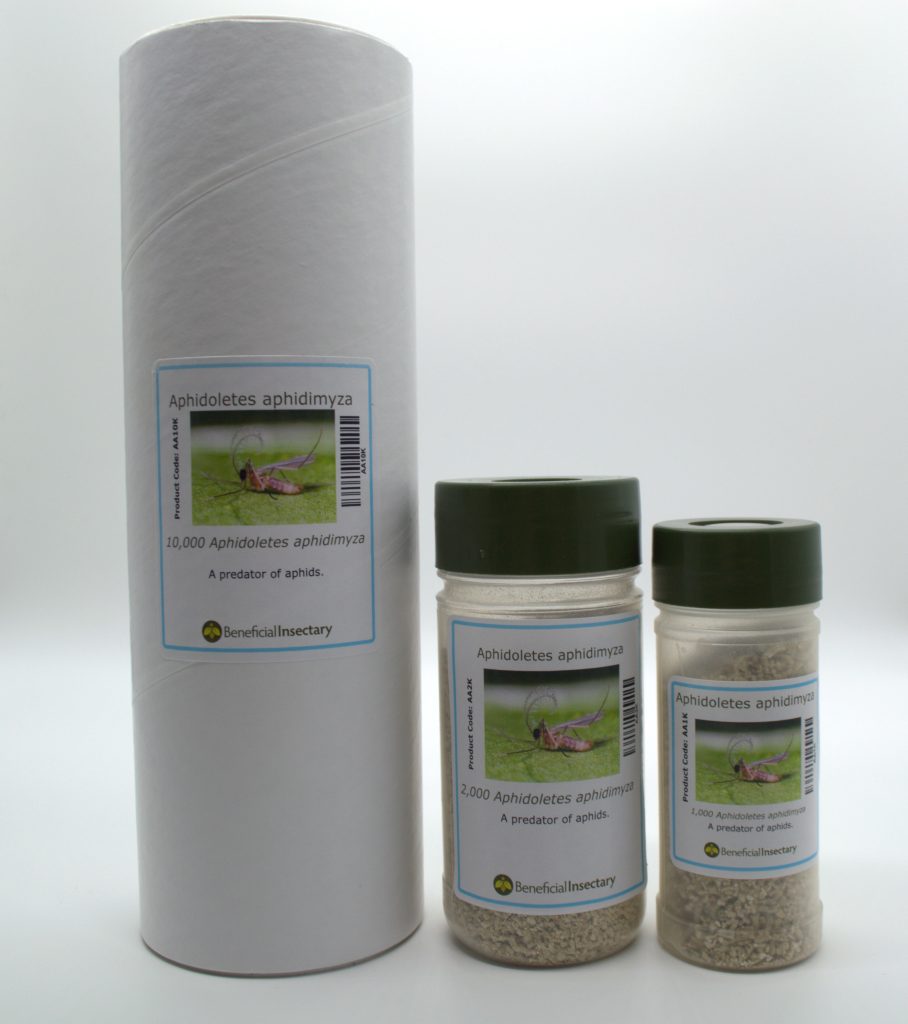APHIDOLETESFORCE™
APHIDOLETESforce™
Aphidoletes aphidimyza is a midge that, in their larval stage, will kill and eat over 60 species of aphids.
Multiple Aphid Species, Including:
Green Peach Aphid (Myzus persicae)
Melon/Cotton Aphid (Aphis gossypii)
Potato Aphid (Macrosiphum euphorbiae)
Fox Glove Aphid (Aulacorthum solani)
Cannabis Aphid (Phorodon cannabis)
Ornamentals
Hemp/Cannabis (not indoors)
Vegetable Crops
Soft Fruits
Tree Nurseries
Greenhouses
Fields
Gardens

The adults are tiny, mosquito-like flies but are harmless to humans. The larvae are bright orange (sometimes reddish), legless maggots that scoot along with the leaves of infested plants, killing and eating aphids. They are best used as a cleanup once aphids are found. After emerging from their pupal case, adult females will find a spider web to land on, where she waits for a male to mate with.
She will then fly off and lay around 250 eggs among aphid colonies. If there are no spider webs in the greenhouse, many growers make “love shacks” with stretched cotton to mimic a spider web.
Studies have shown that spider webs result in more use and more successful mating. Ask a Beneficial Insectary IPM Specialist for more details.
Adult females have exceptional hunting behavior to locate small aphid hotspots among many un-infested plants. Once the eggs hatch, the resulting larvae will bite the knees of aphids and inject a toxin to paralyze them. They then go to the aphid’s body and suck the juices out. If there is a high concentration of aphids, the larvae will paralyze more of them than they eat, which kills them. The conditions for optimum performance are between 64-77°F with a relative humidity of at least 70%.
Use immediately upon receipt.
If not possible, this product can be briefly stored at 6-10° C / 42-50° F. Always adhere to the use-by-date.
RELEASE TIMING
APHIDOLETESforce™ should be released when aphids are first detected.
RELEASE METHOD
Most of the Aphidoletes in the bottle will likely still be in their pupal stage but will emerge as adults within about three days. Release any adults that have emerged by opening the top and allowing them to fly out. If necessary, gently shake the bottle to encourage them to exit. Be sure not to shake out the remaining pupae, though. Since they pupate on the ground naturally, small piles of the remaining pupae can be placed directly onto moist soil near the aphid-infested plants. Alternatively, they can be left in the bottle and checked at least once a day so the newly emerged adults can be released.
Adults may be seen flying in the early evenings, or even later at night.
Females can sometimes be found on spider webs, often with males flying around them. It’s not unusual to see the larvae underneath the leaves in the crop. Since they are bright orange, they stand out very well. Another sign of having Aphidoletes in the crop is finding shriveled aphid bodies and fewer living aphids.
Yellow sticky cards should be removed for the first few days after the release of the midges. Blue sticky cards are acceptable to keep the entire time but avoid releasing them right next to them. These predators cannot be used when the day length is below 12 hours or any time of the year indoors. They can be used in hydroponic systems, but don’t expect any establishment (multiple generations) since they pupate in the soil.
They may at times pupate plants themselves, so use caution if applying to food crops. If ants are present, be sure that they are controlled before releasing Aphidoletes or aphid parasitoids. Aphids produce honeydew that the ants feed on and will protect them from predators or parasitoids. Do not release in combination with Chrysoperla or Amblyseius swirskii since the lacewing larvae will eat the Aphidoletes larvae, and A. swirskii may eat the midge eggs.
Live-Product: Beneficial Insectary strives to guarantee the live delivery of the freshest organisms to our customers. We offer replacements or credits for any compromised shipments to our customers that report any issues or concerns within 24 hours. These issues or concerns must be relayed before releasing any organisms that are suspected of having viability issues. Please do not discard the product. You may be requested to return the shipment for further analysis.
Establishment of BCAs in Crop Settings: Many variables can negatively or positively impact BCA and pest populations in various crops we work with (pesticide applications, watering practices, improper storage methods, cultural/physical/mechanical controls, etc.). Some beneficial organisms require a steady pest presence as a food source to build their population. Others may require alternate food sources, such as pollen or nectar as an example. While other BCAs have specific photoperiod requirements for success. Due to these variables, we cannot guarantee the long- or short-term establishment of the BCAs we sell after the release of the organism(s). We will not offer refunds, discounts, or other credits on products that have already been released. Please adhere to our “Live-Product” disclosure.
PRODUCT Release Method
PRODUCT SPECIFICATIONS
PRODUCT | PACKAGE SIZE & CARRIER | LIFE STAGES | PRODUCT CODE |
|---|---|---|---|
APHIDOLETESforce™-2,000 | 250ml Bottle w/ Vermiculite | Pupae | AA2 |
APHIDOLETESforce™-10,000 | 1L Bottle w/ Vermiculite | Pupae | AA10 |
RELEASE RATES
CLASSIFICATION | RELEASE INFORMATION |
|---|---|
Preventative | 0.05-0.1 Per Sq. Ft. |

CANNABIS ALERT: Release rate suggestions on these pages are usually not sufficient for cannabis growers. For cannabis release rates contact us.
Life Cycle
EGG STAGE
- Eggs are laid inside the host aphid
LARVAE/PUPAE STAGES
- In the greenhouse, larvae live for about a week before dropping into the soil to pupate
- Pupation takes one to two weeks
ADULT STAGE
- Once emerged, adults live approximately two weeks, although most of the female’s eggs are laid in the first couple of days
